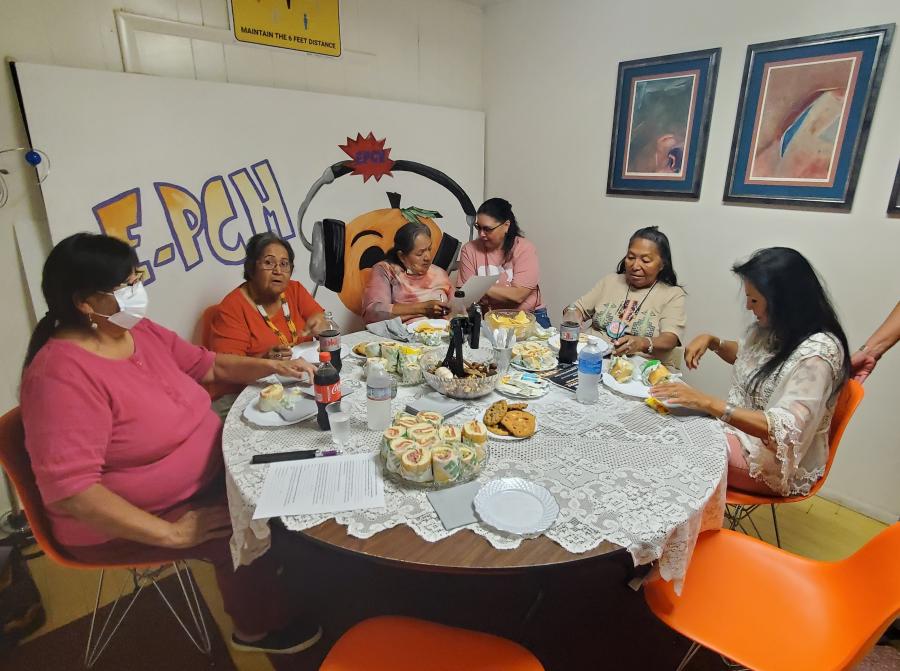In 1863 Kit Carson launched a brutal and relentless search-and-destroy campaign against the Navajo people. Under his command, the US Cavalry swept across the Navajo countryside chopping down fruit trees, destroying crops and butchering sheep. Thousands of Navajos were killed, and approximately 8,500 Navajo men, women and children were captured and forced to walk more than 400 miles in the dead of winter to Fort Summer, a barren, 40-square-mile reservation in eastern New Mexico. This became known in Native American history as "The Long Walk."
More than 100 years later, Navajo people, or Dineh as they call themselves, once again are being removed from their ancestral homelands; their livestock are being seized, they are being harassed by the Bureau of Indian Affairs (BIA) and denied the right to repair their dwellings or build new homes. Why another forced relocation? The Navajo are once again in the way of westward expansion, this time in the form of energy resources development.
The Search for Minerals
In 1909 members of the US Geological Survey conducted an investigation of the northern Arizona plateau, believing that 8 billion tons of recoverable coal lay beneath the land's surface. In the early 1920s, the Los Angeles Department of Water and Power began to study the feasibility of developing southwestern coal resources in order to provide enough electricity for the explosion of development that was beginning to engulf Southern California. In order to protect the air quality of the plants were placed in the Four Corners area, where Arizona, Colorado, Utah and New Mexico meet.
In the mid-1950s the state of Arizona looked to the coal reserves located on the Navajo and Hopi reservation lands as a solution to its growing energy needs. In an all-out effort to tap these energy resources, a coalition of 21 utility companies from Arizona, California, New Mexico, Colorado, Nevada, Utah and Texas joined forces as Western Energy Supply and Transmission Associates (WEST) and proceeded to implement "the Grand Plan." This plan involved the construction of massive coal and nuclear power plants fueled by the vast supply of coal and uranium in the Four Corners region. Throughout the century it became increasingly clear that this part of the Southwest was a major repository of important minerals such as oil, coal and uranium. Efforts to develop these resources led to
1. The creation of the Navajo and Hopi Tribal Councils by the US government.
2. The division of jointly used ancestral lands through the 1974 Navajo- Hopi Land Settlement Act.
3. A federally imposed building moratorium and livestock reduction program for Navajos living on Hopi Partition Land.
4. The relocation of thousands of Navajo people from their homelands.
The 1974 Navajo-Hopi Land Settlement Act created an artificial boundary, dividing in half 1.8 million acres of jointly owned Navajo-Hopi land in northern Arizona. The enactment of this law resulted in governmental efforts to relocate 10-15,000 Navajos who found themselves living on the wrong side of the fence. Sen. Daniel Inouye, Chairman of the Senate Select Committee on Indian Affairs, calls the Navajo-Hopi Land Settlement Act a "measure to settle a century-old land dispute between the Navajo and Hopi Tribes in Northwest Arizona." A look at the events leading up to the 1974 act indicates that it is actually the result of an ongoing effort to develop mineral resources in the area. In order to understand this situation, some background information on American colonial and history up to the 1974 Land Settlement Act is required.
Land History
The 1868 Treaty at Fort Summer established an official Navajo reservation, allowing them to return from four years of internment to but a small portion of their ancestral homeland. The reservation could not sustain the growing Navajo population; through piecemeal legislation it was eventually enlarged to its present size. The Navajo reservation was established to keep the people confined to a specific area of land. In contrast, a reservation surrounding Hopi villages was created expressly to keep certain non-Indian peoples out of the area.
In 1882, President Chester A. Arthur issued an executive order setting aside 2.5 million acres around most, though not all, of the Hopi villages. It was drawn up specifically to evict two Anglo "troublemakers" who had been helping the Hopis resist the forced abduction of their children in order to place them in Mormon boarding schools. This parcel of land, known as the 1882 Executive Order Reservation, was legally set aside for the "use and occupancy of Moqui (Hopi) and such other Indians as the Secretary of the Interior may see fit to settle thereon".
It is this 1882 Executive Order Reservation, later known as the Joint Use Area (JUA), which was divided in half by the 1974 Land Settlement Act. From the time of its inception it was occupied by both Navajo and Hopi people. With the encroachment of white ranchers and the Atlantic and Pacific Railroad in New Mexico, more and more Navajos moved west into the JUA. Despite overcrowding, the two tribes managed to peacefully coexist except for some minor squabbles over land and water use. Although the US government was continually trying to exert control over the Navajo and Hopi people, it displayed little interest in the reservation lands until the early 1900s when important minerals were discovered there.
Oil companies attempted to lease Navajo land for oil resource development in 1922. These attempts were frustrated by the reluctance of the traditional leaders to "defile the Mother Earth." The Navajos called in by the BIA refused to grant more than one lease to one company - Midwest Oil, a subsidiary of Standard Oil. For this reason, a council of "friendly" representatives was needed to negotiate leases.
The Creation of Tribal Councils
In 1923, the Navajo Tribal Council was formed by the federal government. The concept of a central governing body was foreign to the Navajo people. The "tribe" had originally consisted of many family groupings or clans each having their own leader, called naat'aanii (speechmaker), who was chosen by the clan and removed by the same process. Tribal councils, on the other hand, were political entities set up by the US government. Even today they cannot make binding decisions without the signature of the Secretary of the Interior. According to a report filed by the US Commission on Civil Rights, the tribal council was "created in part so that oil companies would have some legitimate representatives of the Navajos through whom they could lease reservation lands on which oil had been discovered." The Navajo Tribal Council was created in order to legitimize resource extraction in the 1882 Executive Order Reservation. Due to the joint ownership of the land, a friendly Hopi Tribal Council was also needed.
In 1935 Congress passed the Indian Reorganization Act, designed to superimpose a political system patterned after Washington upon traditional Indian governing structures. This new system was implemented through the holding of elections on every reservation. Many Hopi people were offended and refused to vote on this issue. After all, their own system of government predates the signing of the Declaration of Independence by more than 1,000 years. The Indian Reorganization Act, however, was passed by a small percentage of Hopi voters. On the day of the Hopi vote, on 1938, only 755, or 37 percent of an estimated 2,000 eligible voters, turned out. With the ratification of the Indian Reorganization Act, the Hopi Tribal Council was established.
Also in 1938, Congress enacted the Mineral Development Act, which provided that "lands within an Indian reservation may, with the approval of the Secretary of the Interior, be leased for mining purposes, by authority of the Tribal Council or other authorized spokesmen for the Indians". The original Hopi Tribal Council lasted only five years, from 1938 to 1943. In 1944 geologists working for a subsidiary of Standard Oil requested a lease to drill within the 1882 Executive Order Reservation. A landmark opinion was issued by the federal government in 1946 stating that "the rights of the Navajos within the area...are co-extensive with those of the Hopis with respect to the natural resources of the reservation". In order to negotiate leases the Hopi Tribal Council had to be revived. As one official of the federal government put it, "It does not appear that leases acceptable to oil companies may be made under exiting law unless the Hopi Indians will organize a tribal council". Just prior to the revival of the Hopi Tribal Council, the federal government created an official Hopi reservation.
The Hopi Reservation and the Joint Use Area
The 1930s brought Dust Bowl conditions to northern Arizona, setting in motion a major livestock reduction program initiated by the Department of the Interior. In order to provide effective administration the department initiated 19 grazing districts throughout the Navajo and Hopi reservations. In 1943 the department created "Grazing District Six," which designated about 650,000 acres of land surrounding the Hopi mesas (within the 1882 Executive Order Area) as exclusively Hopi land. Grazing District Six became the official Hopi reservation. Three years later, Congress passed the Indian Claims Commission Act, which gave Native American groups an opportunity to receive monetary compensation for lost aboriginal lands.
In 1951, the same year that the Hopi Tribal Council was revived, a former government lawyer, John S. Boyden, filed a land claim case for the Hopis under the Indian Claims Commission Act, asserting that the Hopi people had lost land to the Navajos. In 1955, Boyden filed a petition to acquire Hopi mineral rights to the jointly owned land within the 1882 Executive Order Area. That same year, the BIA and the University of Arizona College of Mines completed a $500,000 study of mineral resources on Navajo and Hopi lands, including the Black Mesa formation, which revealed the rich coal and petroleum content of the land. After much administrative deliberation on the competing land claims of the jointly used area, Congress enacted a law in 1958 authorizing the Hopi and Navajo tribal councils to participate in lawsuit to determine the rights and interests of the 1882 Executive Order Area. In 1962, the District Court, in a case known as Healing v. Jones, held that, except for the Hopi reservation land known as Grazing District Six,
the Hopi and Navajo Indian Tribes have joint, undivided, and equal
interests as to the surface and subsurface [land] including all resources
pertaining thereto,…
This area was known as the Joint Use Area and was primarily occupied by Navajo people. Although Boyden's law firm appeared to be concerned with the welfare of the Hopis, a closer look reveals that a serious conflict of interest was taking place. The law firm not only represented the Hopi Tribal Council but big business as well.
Big Business Interests
In 1961 Boyden had secured the interest of Fisher Contracting Company in prospecting for minerals on the Hopi reservation; by 1964 he had successfully opened up 63 percent of the Hopi reservation to oil companies. One of these, Aztec Oil and Gas Co., was a client of Boyden at the time. Boyden's law firm also represented WEST, which by that time included Peabody Coal, Bechtel and Kennecott Copper. A 1966 professional directory listed both "Hopi Indian Tribe" and "Peabody Coal Company" as clients of Boyden's law firm.
Nineteen sixty-six was the same year that Peabody Coal Company was granted the right to mine more than 64,000 acres of coal-laden land in the Black Mesa area - 40,000 of which lay within the Joint Use Area and the rest on Navajo reservation land. This contract, the result of months of negotiations between US secretary of the Interior Stewart Udall, the Navajo Tribal Council, the Hopi Tribal Council (represented by John Boyden), WEST and Peabody Coal, was a great blow to traditional Hopi people, who regard Black Mesa as a sacred site. Southern Pacific soon built the country's first slurry pipeline, diverting much of the already scarce water from Hopi reservation land to bring coal from Black Mesa to two power plants in Arizona and Nevada. Despite this victory for the energy developers, vast amounts of untapped minerals still lay within the Joint Use Area: it contains an estimated 20 billion tons of strippable coal and inestimable amounts of uranium, oil and other minerals.
The joint ownership of the land made negotiations with mining companies nearly impossible. According to an article in the Oil and Gas Journal, "Both tribes have agreed to split mineral rights 50-50, but negotiations are not complete on the surface rights, and it's unlikely this land will be offered until this settled".
Land Dispute and Mineral Rights
The issue of a land dispute between the Navajo and Hopi was not new to Congress, since land title to the JUA had been disputed by the tribal councils for years. The people living on the land, however, were unaccustomed to fences and artificial land divisions; it was not uncommon for Navajo-owned livestock to stray onto Hopi reservation lands. In 1970, therefore, the Hopi Tribal Council created an ordinance declaring Navajo stock on Hopi land to be in trespass and subject to impoundment. This action provoked the Navajo people and blew the land use issue out of proportion. Navajo Tribal Council member Peter MacDonald said that he feared the Navajos would "get their fill of this and take things in their own hands".
The press latched on to this land dispute story, prompting the Hopi Tribal Council to hire the public relations firm Evans and Associates to stage-manage a range war between the two tribal groups. Television crews were brought in to cover roundups of trespassing Navajo stock, and photographs of burned corrals and shot-up water tanks were printed. This public relations firm, as it turns out, also represented WEST, the energy conglomerate engaged in building power plants and strip mines in the Four Corners area. The publicity created a distorted image of Hopi people living in terror of Navajos and of rampant violence on the reservation.
Resettlement and Relocation
In hearings of the House Subcommittee on Indian Affairs, John Boyden pleaded for a division of the land and a reduction of Navajo livestock. He insisted that Navajo intrusions into the Hopi reservation threatened the Hopis with "systematic elimination as a people". In 1974, Congress passed the Navajo-Hopi Land Settlement Act, or Public Law 93-531, which authorized partition of the Joint Use Area. By 1975 prospecting leases for that land had already been signed. The first fences went up in 1977, dividing previously open land, blocking access to sacred sites and disrupting the lives of many Navajo people. Subsequently, a federal program was set up to remove and relocate about 100 Hopi people and between 10,000 and 13,000 people of Navajo ancestry.
Rather than employing military force, the federal government undertook a war of attrition designed to destroy the peoples' ability to remain on the land. It implemented a building moratorium which made it illegal for people to build or even repair their homes, corrals and so on, and a livestock reduction program which limited the number of stock animals a family could own. Because traditional Navajo economy is based on livestock (sheep in particular), these programs represented a direct threat to survival. The people view these programs as a clear attempt to coerce them from their ancestral homelands. Lee Brooke Phillips, staff attorney of the Big Mountain Legal Office, said in a recent interview for New Voice Radio (April 1988), "The reality is that people are really faced with a surrender or starve situation." Since the existing Navajo reservation lands were not large enough to accommodate the number of people to be relocated, 400,000 acres of "New Lands" were designated for Navajo relocation.
Almost all of the "New Lands" (360,000 acres) sit in the Puerco River Basin in eastern central Arizona. A 1979 accident at United Nuclear's uranium mine spilled 94 million gallons of radioactive water and 1,100 tons of toxic solids into the Puerco River, killing livestock and contaminating the entire area. Navajo people have also been relocated to the already overcrowded Navajo reservation as well as to predominantly white border towns. Some, however, have refused to leave their homeland and have stayed on in the Joint Use Area.
These people are now threatened by efforts to step up the relocation via the McCain bill, S.1236, which is meant to "expedite and complete the relocation program." This bill, passed by the Senate Select Committee on Indian Affairs in April, is expected to glide easily through the Senate and House of Representatives. Alternatively, the Cranston bill, S.2452, which has far less Congressional support, would impose a moratorium on the relocation and give traditional leadership (as opposed to the tribal councils) a direct role in finding an acceptable solution.
The idea that this relocation was caused by a land dispute between the Navajo and Hopi people is a distortion reality, a diversion created by business interests in order to gain access to the land and its energy sources.
Article copyright Cultural Survival, Inc.



